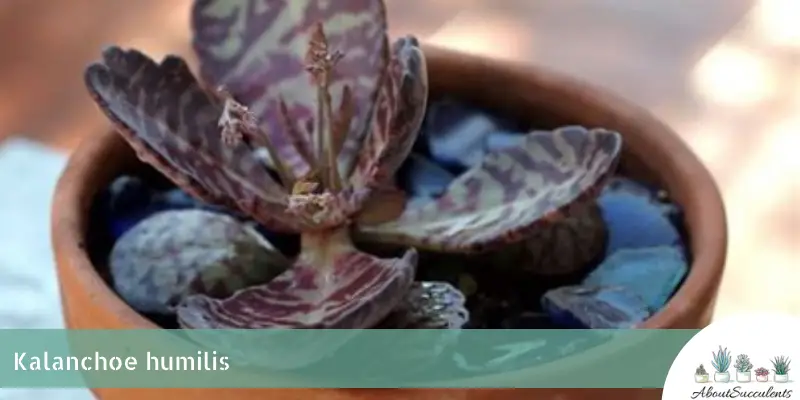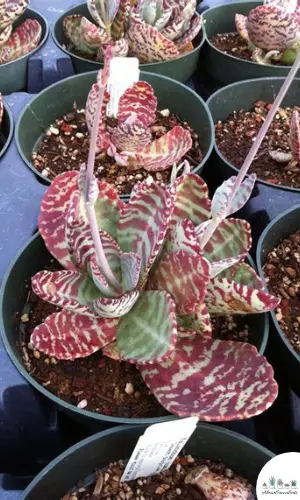
Kalanchoe humilis is a fascinating succulent that easily catches the eyes of onlookers with its green leaves that are mottled with purple spots. The mesmerizing leaves often present the markings in horizontal stripes that give this beautiful succulent plant its common name of Tiger.
A fully-grown Tiger can reach a height of 90cm (36”). If properly taken care of, Kalanchoe humilis will reciprocate your love with small flowers in the mid-summer. The flowers range in color from purple to green.
Kalanchoe humilis is native to Tanzania, Mozambique, and Malawi. It’s part of the Crassulaceae family.
General Information:
Also known as: Tiger
Plant Family: Crassulaceae
Origin: Mozambique, Tanzania, and Malawi
Height: 90cm (36”)
Exposure: Full to partial sun of up to 6 hours
Water Needs: Drought-tolerant succulent only needs water when the soil is completely dry.
Soil Type: Half cactus mix and half potting mix with pumice, perlite, gravel, or sand added to improve drainage.
Soil pH: 6.5
How to Grow and Care for Kalanchoe Humilis
If you’re thinking of starting the relaxing hobby of growing succulents and you don’t have enough time because of your busy schedule, start out your new interest by growing Kalanchoe humilis.
Tiger is an easy succulent to grow and care for. You’ll soon discover that you don’t have to do much to get Kalanchoe humilis to thrive outdoors as part of your rock garden or indoors as an accent houseplant.
Sunlight
Succulent growers love the addition of Kalanchoe humilis in the rock garden. The captivating green and purple leaves plus its height make it a wonderful centerpiece.
Make sure that you plant Tiger in an area in your garden that regularly gets 6 hours of full or partial sunlight.
Without enough sun, the succulent plant will undergo the process of etiolation where its leaves will stretch out as if looking for the sun’s rays. Should etiolation happen, the leaves will weaken and wither.
If you live in a region where the temperature drops below -12.2° C (10° F), we recommend planting Kalanchoe humilis in a pot that you can move indoors. As an indoor plant, place Tiger near a location that gets 6 hours of partial sunlight every day.
Watering

The rule for watering Kalanchoe humilis is simple: Only give it water when the soil is completely dry. If you water more than what the plant requires, its roots will be immersed in a moist environment for a long period of time and will rot.
A sign that the plant needs water is if the soil feels dry to the touch. To be sure, insert a stick at least 1” deep into the soil. Pull it out and feel its end. If the end of the stick feels dry, then you can schedule Tiger for a good soaking.
Here’s a very important tip to keep in mind: Only water the plant at its base and never water it overhead.
Watering Tiger overhead will keep the leaves moist and expose it to the risk of rotting. Also, if the leaves are infected, the droplets may be carried to the other leaves or the neighboring plants.
In the colder months, the soil will remain moist longer. This means that during winter, the watering schedule of the plant will be greatly reduced.
Pot and Soil
Plant Kalanchoe humilis in a ceramic or terracotta pot with a drain hole and mesh cover at the bottom. Pots that are made of ceramic or terracotta will ensure that the soil gets completely dry as it allows for proper evaporation of moisture.
The drain hole with mesh cover will let excess water flow through without losing valuable soil. You know that the soil has received a thorough soaking if it starts leaking excess water through the drain hole.
The best soil to grow Tiger in would be a 50/50 mix of cactus and potting soil. Add ingredients such as perlite, pumice, gravel, or sand to improve drainage.
How to Propagate Kalanchoe Humilis
If you want to add to the number of Tigers in your outdoor garden, you’re in luck because this type of succulent plant can be propagated in 3 ways: Cuttings, Leaf Cuttings, and Seeds.
Method 1: Cuttings
Step 1: Use a sterilized and sharpened knife or garden scissors to cut a part of the plant just above a leaf on the main stem.
Step 2: Leave the cuttings in a dry and warm area and let it grow hard calluses over 2 to 3 days.
Step 3: Once the cuttings have enough calluses, place them on top of well-draining soil.
Step 4: Keep the soil lightly moistened until you see the roots take hold. From there, water the soil only when it’s 100% dry.
Method 2: Leaf Cuttings
Step 1: Cut a healthy leaf from the main plant by using a sterilized and sharpened pair of garden scissors.
Step 2: Let the leaf cuttings develop calluses by placing them in a warm and dry area.
Step 3: When the leaf cuttings have callused, place them on top of well-draining soil.
Step 4: If the roots have not firmed up yet, keep the soil in a moistened state by lightly misting it every day.
Step 5: Once the roots have taken hold of the soil, only give it water when it’s dry.
Method 3: Seeds
Step 1: Purchase high-quality seeds from a reputable garden store.
Step 2: Fill a pot with a 50/50 mix of cactus and potting soil.
Step 3: Plant the seeds 2.5cm (1”) deep and 2.5cm (1”) apart from each other.
Step 4: Place the pot in a location that receives indirect sunlight.
Step 5: Lightly water the soil and cover it with plastic to support germination which might take place in 10 days.
Frequently Asked Questions
Is Kalanchoe Humilis Toxic to Cats and Dogs?
Kalanchoe humilis is not specifically listed among the list of plants that might be toxic to cats and dogs found on the website of the American Society for the Prevention of Cruelty to Animals (ASPCA).
The list is only partial and there have been some findings that indicate Tiger could be toxic to pets.
As an indoor plant, keep Kalanchoe humilis in a location that can’t be reached by your pets.
Why is My Kalanchoe Humilis Dying?
If you suspect that your Kalanchoe humilis is getting weaker and possibly dying, the possible culprits would be overwatering and pest infestation.
Overwatering
If you notice discoloration on Tiger’s beautiful leaves, its roots could be rotting away due to overwatering.
Cut off the discolored parts of the plant with a sanitized knife or garden shears. Remove Tiger from the soil and cut off the rotted roots. Place the succulent in a dry area while you prepare a new pot with fresh soil.
Replant Kalanchoe humilis and only water the soil when you are 100% certain that it’s dried out completely.
Pest Infestation
Similar to other succulent plants, Kalanchoe humilis attracts pests such as mealybugs, aphids, and spider mites. These pests will drain your plant of sap and leave it exposed to disease and infection.
If you notice the appearance of white, cotton-like substances on the leaves, Tiger might have trespassers in mealybugs and spider mites. Spray the plant with neem oil and wipe off the white substances with 70% isopropyl alcohol.
Does Kalanchoe Humilis Produce Flowers?
Yes, Kalanchoe humilis produces small, beautiful flowers that might have a green or purple color in the summertime.
Last Updated on June 9, 2022 by Sofia Lara